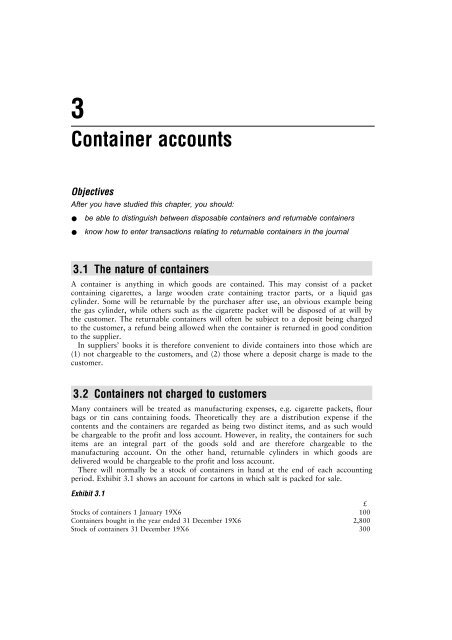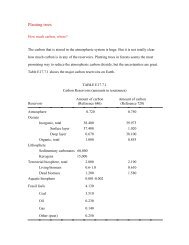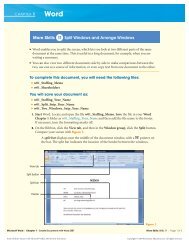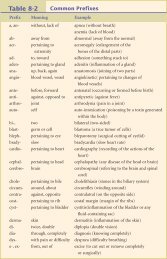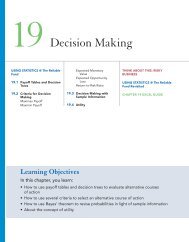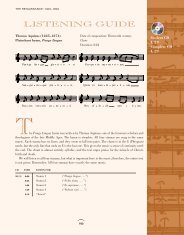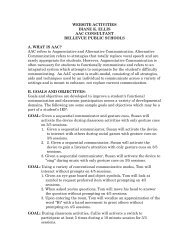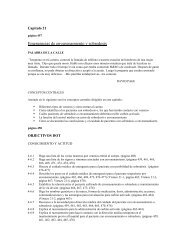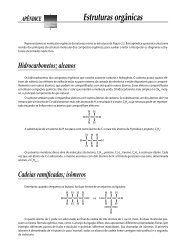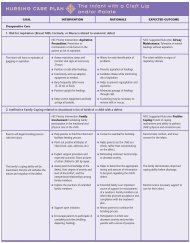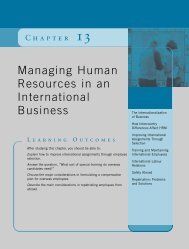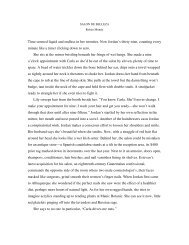Container Accounts
Container Accounts
Container Accounts
You also want an ePaper? Increase the reach of your titles
YUMPU automatically turns print PDFs into web optimized ePapers that Google loves.
3<br />
<strong>Container</strong> accounts<br />
Objectives<br />
After you have studied this chapter, you should:<br />
•<br />
•<br />
be able to distinguish between disposable containers and returnable containers<br />
know how to enter transactions relating to returnable containers in the journal<br />
3.1 The nature of containers<br />
A container is anything in which goods are contained. This may consist of a packet<br />
containing cigarettes, a large wooden crate containing tractor parts, or a liquid gas<br />
cylinder. Some will be returnable by the purchaser after use, an obvious example being<br />
the gas cylinder, while others such as the cigarette packet will be disposed of at will by<br />
the customer. The returnable containers will often be subject to a deposit being charged<br />
to the customer, a refund being allowed when the container is returned in good condition<br />
to the supplier.<br />
In suppliers’books it is therefore convenient to divide containers into those which are<br />
(1) not chargeable to the customers, and (2) those where a deposit charge is made to the<br />
customer.<br />
3.2 <strong>Container</strong>s not charged to customers<br />
Many containers will be treated as manufacturing expenses, e.g. cigarette packets, flour<br />
bags or tin cans containing foods. Theoretically they are a distribution expense if the<br />
contents and the containers are regarded as being two distinct items, and as such would<br />
be chargeable to the profit and loss account. However, in reality, the containers for such<br />
items are an integral part of the goods sold and are therefore chargeable to the<br />
manufacturing account. On the other hand, returnable cylinders in which goods are<br />
delivered would be chargeable to the profit and loss account.<br />
There will normally be a stock of containers in hand at the end of each accounting<br />
period. Exhibit 3.1 shows an account for cartons in which salt is packed for sale.<br />
Exhibit 3.1<br />
£<br />
Stocks of containers 1 January 19X6 100<br />
<strong>Container</strong>s bought in the year ended 31 December 19X6 2,800<br />
Stock of containers 31 December 19X6 300
48 Business Accounting 2<br />
<strong>Container</strong>s<br />
19X6 £ 19X6 £<br />
Jan 1 Stock b/d 100 Dec 31 Manufacturing account 2,600<br />
Dec 31 Cash (bought during the year) 2,800 ,, 31 Stock c/d 300<br />
2,900 2,900<br />
19X7<br />
Jan 1 Stock b/d 300<br />
For returnable containers on which deposits are not charged the question of whether or<br />
not accurate statistical records would be kept would depend on the nature and value of<br />
containers.<br />
3.3 <strong>Container</strong>s on which deposits are charged to customers<br />
There are containers which many purchasers would not return if they were not charged<br />
with a deposit refunded only on return. These are obviously containers which require<br />
more than a marginal effort to return, or those which could be put to alternative uses.<br />
The deposit chargeable must therefore be sufficient to discourage the purchaser from<br />
keeping the containers after use, but should not be so great as to deter him from buying<br />
the goods in the first place. In some instances, a time limit is fixed within which the<br />
container is to be returned to obtain a cancellation of the deposit charged. Common sense<br />
must, however, prevail, as it would be unwise to refuse to allow returns in circumstances<br />
which could bring about a worsening in the firm’s relationship with customers it wished<br />
to retain.<br />
Accounting for containers must therefore fulfil two needs, (a) it must enable some form<br />
of check on the stock of containers, and (b) it must reveal the amount of deposit<br />
returnable to customers. This can be satisfied, for (a) a containers stock account can be<br />
kept, and for (b) a containers suspense account may be opened.<br />
Volume 1 has already illustrated the need for the depreciation of containers to be<br />
provided normally by the revaluation method. The containers stock account will therefore<br />
provide for the depreciation element by the process of revaluing the containers at the end<br />
of each accounting period. Each container account may also include, in addition to the £<br />
columns, further columns for quantities and for the monetary rates at which the<br />
transactions are carried out.<br />
3.4 Comprehensive example where a deposit is chargeable<br />
Exhibit 3.2<br />
A new firm, IVY and Co, sells its goods in crates on which a deposit is chargeable to the<br />
customer, a credit being allowed on their return within three months.<br />
During the year ended 31 December 19X5:<br />
A 50 crates were bought for £3 each.<br />
B 180 crates were sent to customers, these being charged to their accounts at £4<br />
deposit each. (You may well wonder how 180 crates can be sent out when only<br />
50 have been bought by IVY and Co. The figure of 180 consists of recounting<br />
the same crates, as they are sent out and returned several times each year.)
C 150 crates were returned by customers, credits being entered in their accounts for<br />
£4 each.<br />
D 10 crates were kept by customers beyond the three months’limit, and they<br />
therefore forfeited their right to return them to obtain a refund of the deposit.<br />
E 2 crates were damaged and were sold for £1 each.<br />
On 31 December 19X5 the following facts are relevant:<br />
F There were 20 returnable crates with customers.<br />
G There were 18 crates at IVY’s warehouse.<br />
The stock of crates at 31 December 19X5 are to be valued at £2 each to provide for<br />
depreciation through usage.<br />
The identifying letters A to G are shown against the recorded transactions in the<br />
accounts that now follow.<br />
<strong>Container</strong>s Stock<br />
Rate No. Rate No.<br />
£ £ £ £<br />
19X5<br />
19X5<br />
Dec 31 Cash (bought during Dec 31 <strong>Container</strong>s suspense:<br />
the year) A 3 50 150 kept by customers D 4 10 40<br />
,, 31 Cash: damaged crates<br />
E 1 2 2<br />
,, 31 Profit and loss: cost<br />
of container usage 32<br />
,, 31 Stock c/d<br />
In warehouse G 2 18 36<br />
At customers F 2 20 40<br />
50 150 50 150<br />
19X6<br />
Jan<br />
1 Stock b/d<br />
In warehouse G 2 18 36<br />
At customers F 2 20 40<br />
<strong>Container</strong>s Suspense<br />
Rate No. Rate No.<br />
£ £ £ £<br />
19X5<br />
19X5<br />
Dec 31 Sales ledger: crates Dec 31 Sales ledger: crates<br />
credited to customers’charged to customers’<br />
accounts on return C 4 150 600 accounts B 4 180 720<br />
,, 31 <strong>Container</strong>s stock:<br />
kept by customers D 4 10 40<br />
,, 31 Deposits on crates<br />
returnable c/d F 4 20 80<br />
180 720 180 720<br />
19X6<br />
Jan<br />
The balance sheet will show the balances in the following manner:<br />
<strong>Container</strong> accounts 49<br />
1 Deposits on crates<br />
returnable b/d F 4 20 80
50 Business Accounting 2<br />
IVY&Co<br />
Balance Sheet as at 31 December 19X5<br />
Current assets £<br />
Crates – at valuation 76<br />
Current liabilities<br />
<strong>Container</strong>s . suspense – deposits returnable 80<br />
3.5 Comprehensive example where there is a true charge<br />
Sometimes containers are charged out to customers at an initial price greater than that<br />
allowed on their return. The difference represents a hiring charge. If the same data is<br />
taken as in Exhibit 3.2 but, instead of £4 being allowed on return, it had been been<br />
restricted to £3, the accounts would have appeared as follows:<br />
<strong>Container</strong>s Stock<br />
Rate No. Rate No.<br />
£ £ £ £<br />
19X5<br />
19X5<br />
Dec 31 Cash (bought during Dec 31 <strong>Container</strong>s suspense:<br />
the year) 3 50 150 kept by customers 3 10 30<br />
,, 31 Profit and loss: profit ,, 31 Cash: damaged<br />
on container usage 138 crates 1 2 2<br />
,, 31 <strong>Container</strong>s suspense:<br />
Hiring charge 180<br />
,, 31 Stock c/d<br />
In warehouse 2 18 36<br />
At customers 2 20 40<br />
50 288 50 288<br />
19X6<br />
Jan<br />
1 Stock b/d<br />
In warehouse 2 18 36<br />
At customers 2 20 40<br />
<strong>Container</strong>s Suspense<br />
Rate No. Rate No.<br />
£ £ £ £<br />
19X5<br />
19X5<br />
Dec 31 Sales ledger: crates Dec 31 Sales ledger: crates<br />
credited to customers’charged to customers’<br />
accounts on return 150 450 accounts 4 180 720<br />
,, 31 <strong>Container</strong>s stock:<br />
kept by customers 3 10 30<br />
,, 31 <strong>Container</strong>s stock<br />
hiring charge 180<br />
,, 31 Deposits on crates<br />
Returnable 3 20 60<br />
180 720 180 720<br />
19X6<br />
Jan<br />
1 Deposits on crates<br />
returnable b/d 3 20 60
<strong>Container</strong> accounts 51<br />
The balance sheet would have appeared in the following manner:<br />
IVY&Co<br />
Balance Sheet as at 31 December 19X5<br />
Current assets £<br />
Crates – at valuation 76<br />
Current liabilities<br />
<strong>Container</strong>s suspense – deposits returnable 60<br />
Main points to remember<br />
1 <strong>Container</strong>s will either be disposable and treated as part of the cost of sales, or they<br />
will be returnable and involve the taking and returning (possibly only part) of a<br />
deposit.<br />
2 Accounting for containers must enable some form of check on the stock of containers<br />
and must reveal the amount of returnable customer deposits held.<br />
3 Both a container stock account and a container suspense account are used in order to<br />
record details relating to returnable containers.<br />
Review questions<br />
3.1 D Clark’s manufactures are sold in boxes which are returnable. They are charged out to<br />
customers at £8 each and credit of £6 is given for each box returned within two months. For the<br />
purpose of the annual accounts, the value of boxes in the factory and those in customers’hands,<br />
which had been invoiced within two months, was taken as being £1.50 each. The quantities of these<br />
on 31 January 19X3 were 600 and 4,000 respectively.<br />
The following were the transactions as regards boxes during the year ended 31 January 19X4<br />
• Purchases – 5,000 at £2 each<br />
• Invoiced to customers – 17,000<br />
• Returned by customers – 14,000<br />
• 450 could no longer be used and were sold, realising £100.<br />
The number of boxes invoiced after 30 November 19X3 and still in customers’hands on 31<br />
January 19X4 was 6,200.<br />
Required:<br />
Write up the accounts in the books of D Clark to record these transactions and to show the profit<br />
on boxes and the quantities involved.<br />
3.2 A company makes a charge to its customers for cases in which the product is delivered. If<br />
they are returned in good condition within two months a refund is made.<br />
At the start of the year there were 9,600 cases in stock at the company’s warehouse and 6,100 in<br />
the hands of customers supplied within the previous two months. The company bought 18,000 new<br />
cases during the year and following a dispute with a supplier returned 4,000 new cases for which a<br />
credit note of £11,610 was received. At 31 December 19X6 there were still in the hands of<br />
customers 4,800 supplied during the previous two months.<br />
During the year 19X6, 47,600 cases were sent to customers and 43,100 returned by them. The<br />
company scrapped 3,500 damaged cases and sold the timber for £55. A physical check of cases in<br />
stock in 31 December 19X6 revealed an unaccounted deficit of 420 cases.
52 Business Accounting 2<br />
• New cases cost £3 each<br />
• Cases were charged out to customers at £5 each<br />
• Customers were credited £4 on the return of each case<br />
• Cases were valued for stocktaking at £2 each<br />
Show the accounts in the books for 19X6 to record the above, and the balances of cases, in<br />
quantities and values at 31 December 19X6.<br />
You are required to deduce the following missing information from the details above:<br />
(a) The number of cases kept by customers over the two-month limit for returning them.<br />
(b) The number of cases in the warehouse on 31 December 19X6.<br />
3.3 S Limited delivers its product to customers in returnable containers. These are invoiced to the<br />
customer at £20 each and, if returned in good condition within six months, are credited in full. The<br />
containers are purchased for £10 each.<br />
At 30 June 19X6, there were 2,000 containers held in S Limited’s warehouse and provision was<br />
made in the 19X6 accounts for an estimated liability in respect of 5,500 containers in customers’<br />
hands. During 19X7, 1,250 new containers were purchased and 120 were scrapped.<br />
8,750 containers were charged to customers and 9,050 containers were returned within the<br />
six-month period.<br />
At 30 June 19X7, the physical stocktaking showed 3,390 containers in the warehouse and<br />
information derived from customers indicated that there was a potential liability in respect of 4,950<br />
containers. The stocks of containers are valued at cost price.<br />
Required:<br />
Prepare the containers stock account and the containers suspense account necessary to record these<br />
transactions in the books of S Limited.<br />
(Chartered Institute of Management Accountants)<br />
3.4 Lagg Ltd sells its goods in cases. These cases are purchased by the company at £6 per case,<br />
but each case is written down to a standard book value (SBV) of £5 per case immediately it is<br />
purchased. For stocktaking purposes, all cases are valued at £5 per case irrespective of whether they<br />
are still in stock or in the hands of the customers. Cases are charged out to customers at £10 per<br />
case, but the customer is credited with £8 per case if the case is returned in good condition within<br />
three months of receipt.<br />
The following information relates to the year to 31 March 19X7:<br />
1 Stock of cases at 1 April 19X6: Cases<br />
In stock 1,000<br />
In hands of customers 1 January 19X6 3,000<br />
2 During the year, 2,000 cases were purchased.<br />
3 25,000 cases were issued to customers.<br />
4 23,000 cases were returned by customers within the time limit.<br />
5 1,500 cases were not returned within the time limit and were duly paid for by the customers.<br />
Cases still in the hands of customers at 31 March 19X7 had all been invoiced since 1 January<br />
19X7.<br />
6 100 cases kept in stock by Lagg had been damaged and were beyond repair.<br />
7 £1,400 had been spent on repairing some slightly damaged cases.<br />
8 50 other damaged cases had been sold for £2 per case.<br />
In order to keep an accurate record of its transactions in cases, Lagg maintains the following<br />
accounts:<br />
(i)<br />
(ii)<br />
a cases stock account in which cases are recorded at their standard book value;<br />
a cases suspense account in which cases in the hands of customers are recorded at their return<br />
price;
(iii) a cases sent to customers account in which cases sent to customers are recorded at their issue<br />
price; and<br />
(iv) a cases profit and loss account.<br />
Required:<br />
Write up the following accounts in the books of Lagg Ltd for the year to 31 March 19X7;<br />
(a) cases stock account;<br />
(b) cases suspense account;<br />
(c) cases sent to customers account; and<br />
(d) cases profit and loss account.<br />
(Association of Accounting Technicians)<br />
3.5A KRR Ltd sells goods in containers which are charged to customers at £2.00 each. Customers<br />
are credited with £1.25 for each container returned within four months.<br />
On 31 December 19X7, there were 1,580 containers on the company’s premises and 5,520<br />
containers, the time limit for the return of which has not expired, were held by customers.<br />
During 19X8:<br />
(i) KRR Ltd purchased 8,700 containers for £1 each.<br />
(ii) 26,460 containers were charged to customers.<br />
(iii) 23,720 containers were returned by customers and credited to them.<br />
On 31 December 19X8, customers held 6,000 containers, the time limit for the return of which had<br />
not expired.<br />
For purposes of the annual accounts of KRR Ltd, all stocks of containers on the company’s<br />
premises and returnable containers in the possession of customers are valued, at £1 each.<br />
You are required to show the container stock account and the container trading account for the<br />
year 19X8. These accounts should be provided with additional memorandum columns in which<br />
quantities are to be shown.<br />
(Institute of Chartered Secretaries and Administrators)<br />
3.6A The G Company supplies gas in expensive containers which are returnable after use. These<br />
containers cost £20 each and are charged out to customers on sale or return within six months at<br />
£26 each. Provided they are returned within the six months period they are credited at £23 each. As<br />
each container is returned it is inspected and overhauled at a cost of £2.<br />
At the end of the year the company values all returnable containers in customers’hands and<br />
containers held in stock at £16 each.<br />
You are advised that:<br />
At the At the<br />
Beginning of End of<br />
the Year theYear<br />
<strong>Container</strong>s held by the company 2,760 3,144<br />
Returnable containers held by customers 4,790 2,910<br />
During the year 3,100 new containers were purchased, 20,620 were invoiced to customers and<br />
17,960 were returned. On inspection 260 required additional repairs costing £325 and 56 had to be<br />
sold as scrap for £60.<br />
From the information given above prepare:<br />
(a)<br />
(b)<br />
returnable containers suspense account;<br />
an account showing the profit or loss on dealings in containers.<br />
(Chartered Institute of Management Accountants)<br />
<strong>Container</strong> accounts 53


